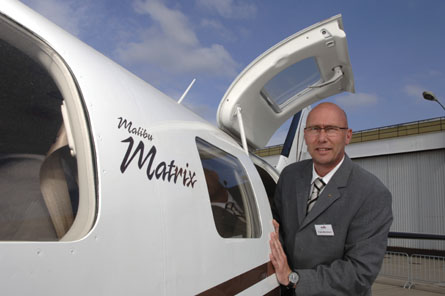These are tough times for general aviation manufacturers.
Piston deliveries are down more than 50% compared with last year and nearly 70% lower than in 2007.
Thousands of production workers are on furlough and nearly every general aviation factory in the world is shutting down for at least a couple of weeks this summer.
With new orders reduced to a trickle, manufacturers badly need another source of cash to continue investing in new products.
But securing new capital in the current environment, where a lack of finance has forced customers to defer aircraft acquisitions, is no easy feat.
However, the ability of Piper, one of general aviation's biggest names, to line up a new owner and secure fresh capital despite the recession offers a ray of hope in an otherwise gloomy industry.
 |
|---|
© PiperPiper's first jet, the PiperJet, will make its air show debut at Oshkosh this month |
"We were all very encouraged by a known entity wanting to invest in a longstanding, traditional company with great roots in the general aviation industry," says General Aviation Manufacturers Association chief executive Pete Bunce.
The "known entity" is Imprimis, a Singapor investment firm that at the beginning of May acquired 100% of Piper from American Capital.
Imprimis has deep pockets funded by the government of Brunei, one of the world's richest countries, and sees its first aviation investment as a way to diversify its portfolio and tap into the industry's budding potential in Asia.
The deal couldn't have come at a better time for Piper, which had been on the selling block for some time and could have languished without new investment.
Imprimis will give it the funds not only to survive the downturn, but to support an ambitious expansion programme and a new line of products starting with the company's first jet, which will make its air show debut this month at Oshkosh (see page 20).
Asian expansion
New Piper chief executive Kevin Gould says Imprimis will particularly help it expand in Asia, using the investment firm's knowledge of the region.
"They have got a perspective of the Asia-Pacific region that is very experienced and they know very well what potential that region holds," says Gould.
In recent years, the industry has been focused particularly on opportunities in Asia's two biggest nations, India and China, he adds.
But development of general aviation in China has been painfully slow because the military refuses to open up most of its airspace, and India still poses many infrastructure challenges.
Instead, Gould sees more near-term opportunities in Australia and South-East Asia, including Indonesia and Malaysia.
"We are focused on expanding internationally with a particular focus on South-East Asia and Australia," he says. "We have a lot of international opportunity we're going to pursue with the new owner."
Bunce agrees there are "opportunities throughout Asia for general aviation" and points out this is not the first time a US general aviation manufacturer has attracted Asian investment.
"Singapore and Malaysia have a lot of potential and Indonesia is perfect for general aviation," he says.
"In India opportunities abound, but obviously there are infrastructure issues there. I wish aviation in China could reach its potential faster, but the military still pretty much has a lock on the airspace."
Australia is different from the rest of the region because it has a highly developed general aviation industry.
But although there are about 3,000 Pipers in Australia, Gould says there has been little activity there in recent years. "We've been absent for 20 years - it's time for us to get back there," he adds.
Heyday
Back in Piper's heyday in the 1960s and 1970s, when it was producing an average of 14 aircraft a day, sales were robust "in all four corners of the world", says Gould.
In recent years, Piper has re-established itself in the US market, but it has still not re-emerged as a strong player in several international markets, including Australia.
"We have a strong brand internationally, but everyone is familiar with what we did in those 20 years from 1960 to 1980," says Gould. "We want to make it relevant to current times."
Piper has had some international success in recent years. Last year, 40% of its sales were overseas and Gould says: "This year will be at least that." But most of these sales have been in Europe, Canada and Brazil.
In Asia, says Gould, Piper aims to sell trainers to flight schools as several airlines in the region - many of which now send their ab-initio students overseas for training - look to develop local capabilities.
He also sees an emerging requirement in Indonesia for a mix of aircraft, given its large and growing population, developing economy and unique archipelago geography that makes long-distance road travel impossible.
For now, Gould declines to spell out how Piper plans to develop the Asian market, saying it is not yet clear whether there will be changes in its dealer structure in the region or whether it will open its own Asian office. "We are developing our plans," he says.
"We will put together a very thoughtful business plan. For the time being, it remains a strategic plan. We hope to really get things going by the end of this year."
 |
|---|
© PiperThe six-seat piston Matrix, introduced in 2007, will be a key part of Piper's planned international resurgence |
A key part of Piper's planned international resurgence will be the Matrix, a six-seat piston that was introduced in late 2007.
Last year, Piper delivered 101 Matrixes, accounting for nearly half its total piston deliveries.
Although it has recently sold four Matrixes in Brazil, where the aircraft is seen as ideal for jungle flying, Gould says most overseas piston-aircraft owners are not yet familiar with the Matrix.
Piper also sees an international market for the PiperJet, which flew for the first time last year.
Piper was forced to slow development of the jet last year because of financial pressures, says Gould.
After its change of owner, Piper received the cash to reaccelerate the programme, but it not yet ready to provide a new schedule for certification and delivery. "Our new ownership group is dedicated to providing capital for the jet and other projects," Gould points out.
He promises new pistons and turbines that will "address gaps in the product line" and says these projects are under way, but it is too early to give any specifics.
Like all other general aviation manufacturers, Piper has had a difficult year. It has had to cut production and headcount by 50% from 2007 levels, when it delivered 216 pistons and 52 turboprops with a workforce of 1,250.
Piper now has about 620 staff on furlough and its remaining 630 employees have been forced to take one week's unpaid holiday a month since April.
To save on factory costs and avoid further furloughs, Piper plans to continue shutting down one week a month for the rest of the year, although Gould says some shutdowns will be cancelled if sales improve.
"The key now is to be nimble and react quickly," he stresses.
Piper's workers have understood the situation, says Gould: "We are open with them on our plans and where the business is going."
Gould hopes to eventually recall all Piper's furloughed employees, perhaps starting later this year. "There are some good former employees with good skills we'd really like to bring back," he says.
Gould believes Piper will match and eventually exceed its 2008 output, which was its best since 2001 (see chart). "I have no doubt it will reach those levels and higher," he says. "And I think we'll continue to grow and grow in the future.
"I think by the end of the year we'll start to see an upswing. I don't think it will be a V, but it will be steady."
Gould says it is hard to predict how long it will take Piper to return to its 2008 output level, but he is confident the company is now better positioned, adding: "If the economy recovers, we have a really bright future."
Gould points out the company is now debt free and will have fresh products ready when the recovery comes.
He says Piper is well positioned because it reacted quickly by decreasing production, ensuring inventories were kept low.
"We took steps two to three months ahead of our competitors to dial back," he says, adding that Piper managers are meeting almost daily to see if further production tweaks are needed "so we don't flood our distribution channel".
Although Piper is not currently producing some of its lower-end models, such as the Archer and the Arrow, Gould says these models are still being sold and production will resume if there is demand. "We didn't throw out the tooling," he points out.
Piper also has no Senecas in the pipeline at the moment, but will produce them again if an order comes in. "The Matrix is kind of cannibalising Saratoga demand," says Gould. "That's OK. The product line is still very full."
No stranger to GA
 |
|---|
© PiperKevin Gould, Piper chief executive |
Gould, who took over from James Bass at the beginning of July, is no stranger to Piper or general aviation.
He joined the company in 2005 after spending two years as vice-president of operations at Adam Aircraft.
Although Imprimis, headed in Singapore by Stephen Berger, will help Piper expand its Asian footprint, Gould will be in charge of an executive team that otherwise has not changed and will continue to oversee the entire company from its Florida headquarters.
"It will be a seamless transition," says Gould. "This executive team has been with each other for four years. We know the business. We know the industry."
Source: Flight International













